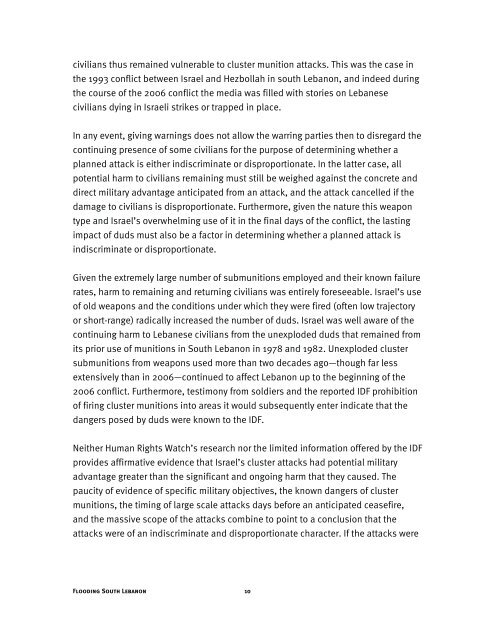Flooding South Lebanon - Human Rights Watch
Flooding South Lebanon - Human Rights Watch
Flooding South Lebanon - Human Rights Watch
You also want an ePaper? Increase the reach of your titles
YUMPU automatically turns print PDFs into web optimized ePapers that Google loves.
civilians thus remained vulnerable to cluster munition attacks. This was the case in<br />
the 1993 conflict between Israel and Hezbollah in south <strong>Lebanon</strong>, and indeed during<br />
the course of the 2006 conflict the media was filled with stories on Lebanese<br />
civilians dying in Israeli strikes or trapped in place.<br />
In any event, giving warnings does not allow the warring parties then to disregard the<br />
continuing presence of some civilians for the purpose of determining whether a<br />
planned attack is either indiscriminate or disproportionate. In the latter case, all<br />
potential harm to civilians remaining must still be weighed against the concrete and<br />
direct military advantage anticipated from an attack, and the attack cancelled if the<br />
damage to civilians is disproportionate. Furthermore, given the nature this weapon<br />
type and Israel’s overwhelming use of it in the final days of the conflict, the lasting<br />
impact of duds must also be a factor in determining whether a planned attack is<br />
indiscriminate or disproportionate.<br />
Given the extremely large number of submunitions employed and their known failure<br />
rates, harm to remaining and returning civilians was entirely foreseeable. Israel’s use<br />
of old weapons and the conditions under which they were fired (often low trajectory<br />
or short-range) radically increased the number of duds. Israel was well aware of the<br />
continuing harm to Lebanese civilians from the unexploded duds that remained from<br />
its prior use of munitions in <strong>South</strong> <strong>Lebanon</strong> in 1978 and 1982. Unexploded cluster<br />
submunitions from weapons used more than two decades ago—though far less<br />
extensively than in 2006—continued to affect <strong>Lebanon</strong> up to the beginning of the<br />
2006 conflict. Furthermore, testimony from soldiers and the reported IDF prohibition<br />
of firing cluster munitions into areas it would subsequently enter indicate that the<br />
dangers posed by duds were known to the IDF.<br />
Neither <strong>Human</strong> <strong>Rights</strong> <strong>Watch</strong>’s research nor the limited information offered by the IDF<br />
provides affirmative evidence that Israel’s cluster attacks had potential military<br />
advantage greater than the significant and ongoing harm that they caused. The<br />
paucity of evidence of specific military objectives, the known dangers of cluster<br />
munitions, the timing of large scale attacks days before an anticipated ceasefire,<br />
and the massive scope of the attacks combine to point to a conclusion that the<br />
attacks were of an indiscriminate and disproportionate character. If the attacks were<br />
<strong>Flooding</strong> <strong>South</strong> <strong>Lebanon</strong> 10
















